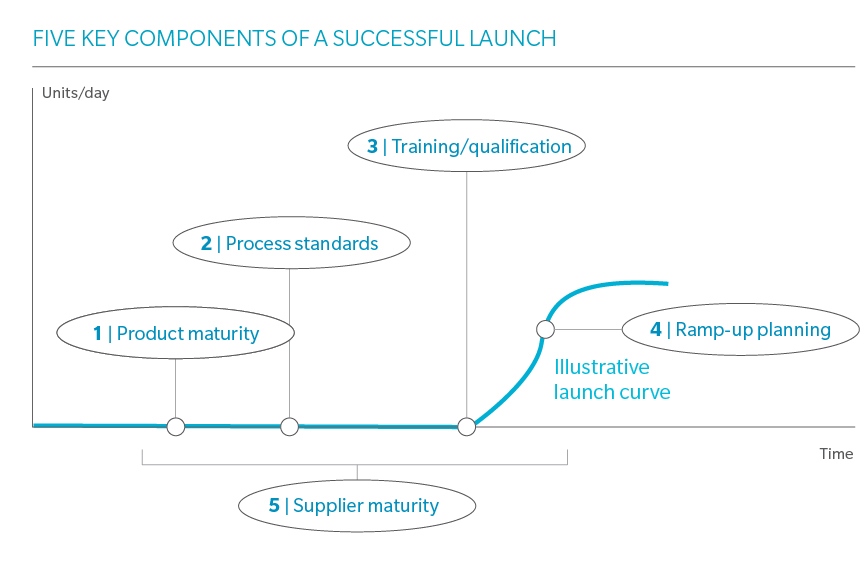Currently, more than 350 new vehicles are launched annually, a trend that Oliver Wyman expects to continue until at least 2025. This means that leading global automakers must cope with more than 20 launches a year; cars debut with several regional specifications and engine variants, and dozens of configurations. In addition, many models feature new materials, such as carbon fiber; new powertrains, such as plug-in hybrids; and highly complex software. At the same time, automakers are encountering rising cost pressure in the form of capital investment needs and operating costs. To cope with these challenges, automakers’ production and production planning arms must boost their launch performance to the next level of excellence, while reining in the costs of doing so.
Big Potential
Based on a simple back-of-the-envelope calculation that assumes there are 350 launches a year of models with a production volume of at least 50,000 units in the launch year, and that launching causes an average increase of five hours per unit (HPU) at a global average labor cost of about €15 per hour, €1.3 billion of value are at stake for the automotive industry each year. When launch issues are factored across the entire value chain – including Tier 1 suppliers – the potential costs could exceed €5 billion. Launch HPU varies significantly among automakers, ranging from two to 20 during the launch year. Vehicle class and location of production have little effect on HPU. What does make a difference is the automaker’s launch philosophy.
European automakers appear to struggle the most with extended time-to-market, a high degree of inefficiencies, a large increase in HPU, as well as a high number of required prototypes. With a product-centered approach and high quality requirements, they regularly face late design changes and a lack of parts maturity. Launches are even more complex due to little carry-over of parts and extensive use of new technologies. Therefore, many European automakers see HPU increases of five to ten or more. Japanese and Korean automaker HPU increases are generally well below five, and in some cases, even as low as 0 to 0.5, due to their more stringent, process-oriented approach. The downside to this approach, however, is a lack of flexibility. A growing number of top managers at these brands have raised concerns about being limited in their ability to equip new models with features that meet the latest customer requirements. The philosophy of US automakers tends to be somewhere in between the European and Asian models.
Successful Launches
Oliver Wyman has defined five key measures automakers should consider to improve launch efficiency and reduce waste.

- Product maturity: To ensure a high degree of product maturity, best-practice companies focus on a strong link between production and R&D functions. Consistent change management, combined with strict enforcement of maturity gates, helps limit late design changes. One European automaker implements this rigorous change management process 35 months before start of production (SOP). Another lever is the level of carryover in parts. Best-practice automakers achieve a vehicle development process (VDP) of less than 38 months and require only up to 100 prototype and validation units, because of extensive use of digital/virtual technology.
- Process standards: Manufacturing and logistics standards help to reduce HPU during ramp-up. Standardized production processes need to be actively supported within the organization, including the use of simplified tools and seamless transfer of know-how. Korean and Japanese automakers follow a process-driven and launch-oriented product architecture. This includes the use of a frame-carrier concept, with highly flexible work cells that are implemented in the body shop and during assembly, as well as cross-plant launch teams or a common bill of processes.
- Training/qualification: Although most automakers identify employee qualifications as a key lever for a successful launch, they handle this very differently. While a European automaker focuses on leveraging production downtimes early on, a US company trains its employees based on the actual time of use. In the past few years, more self-help tools and virtual training programs have been developed to further enhance workers’ skills. Ultimately, successful launches happen when these best practices are followed: use train-the-trainer approaches, emphasize on-the-job training over classroom training, and provide training that is as versatile as needed but as focused as possible.
- Ramp-up planning: A fast production ramp-up is a critical lever for successful launches. Asian players typically follow an online launch with a rolling model change. The launch typically “belongs” to the plant and does not include any buffer times for previous tasks, such as process development or engineering. The ramp-up curve is a given, and not a resulting consequence. However, there are other best practices. One American automaker, for example, tries to work with targeted clock times as early as possible, while keeping empty spaces between vehicles in production.
- Supplier maturity: Early and strong collaboration with suppliers improves part readiness and keeps the component maker from becoming a bottleneck. Automakers, however, have different collaboration approaches: Some automakers provide highly detailed specs and give suppliers limited room for non-compliance while implementing strictly governed processes. Other car manufacturers want a higher level of supplier involvement, providing them with more freedom as well as encouraging proactive support.
Closing The Gap
Successful and efficient launch management is a challenging task that will become even more critical in the future. Cross-discipline collaboration among departments, functions, and regions as well as early and deep integration of suppliers is crucial for successful launches. Mechanical, functional, and organizational aspects of the assembly need to be flawless and therefore require a high degree of information sharing as well as the ability to accurately process large volumes of data. A focused and strict launch management, featuring a higher degree of standardization in processes, better integration along the value chain, and a comprehensive qualification approach for employees, can enable automakers to turn launches from a constant struggle into a common, business-as-usual success.






